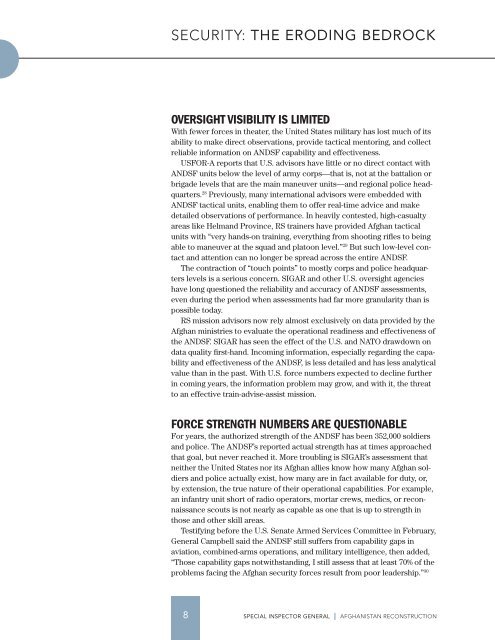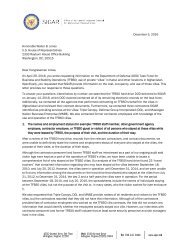SIGAR
2016-04-30qr
2016-04-30qr
You also want an ePaper? Increase the reach of your titles
YUMPU automatically turns print PDFs into web optimized ePapers that Google loves.
Security: The eroding bedrock<br />
Oversight Visibility Is Limited<br />
With fewer forces in theater, the United States military has lost much of its<br />
ability to make direct observations, provide tactical mentoring, and collect<br />
reliable information on ANDSF capability and effectiveness.<br />
USFOR-A reports that U.S. advisors have little or no direct contact with<br />
ANDSF units below the level of army corps—that is, not at the battalion or<br />
brigade levels that are the main maneuver units—and regional police headquarters.<br />
28 Previously, many international advisors were embedded with<br />
ANDSF tactical units, enabling them to offer real-time advice and make<br />
detailed observations of performance. In heavily contested, high-casualty<br />
areas like Helmand Province, RS trainers have provided Afghan tactical<br />
units with “very hands-on training, everything from shooting rifles to being<br />
able to maneuver at the squad and platoon level.” 29 But such low-level contact<br />
and attention can no longer be spread across the entire ANDSF.<br />
The contraction of “touch points” to mostly corps and police headquarters<br />
levels is a serious concern. <strong>SIGAR</strong> and other U.S. oversight agencies<br />
have long questioned the reliability and accuracy of ANDSF assessments,<br />
even during the period when assessments had far more granularity than is<br />
possible today.<br />
RS mission advisors now rely almost exclusively on data provided by the<br />
Afghan ministries to evaluate the operational readiness and effectiveness of<br />
the ANDSF. <strong>SIGAR</strong> has seen the effect of the U.S. and NATO drawdown on<br />
data quality first-hand. Incoming information, especially regarding the capability<br />
and effectiveness of the ANDSF, is less detailed and has less analytical<br />
value than in the past. With U.S. force numbers expected to decline further<br />
in coming years, the information problem may grow, and with it, the threat<br />
to an effective train-advise-assist mission.<br />
Force Strength Numbers Are Questionable<br />
For years, the authorized strength of the ANDSF has been 352,000 soldiers<br />
and police. The ANDSF’s reported actual strength has at times approached<br />
that goal, but never reached it. More troubling is <strong>SIGAR</strong>’s assessment that<br />
neither the United States nor its Afghan allies know how many Afghan soldiers<br />
and police actually exist, how many are in fact available for duty, or,<br />
by extension, the true nature of their operational capabilities. For example,<br />
an infantry unit short of radio operators, mortar crews, medics, or reconnaissance<br />
scouts is not nearly as capable as one that is up to strength in<br />
those and other skill areas.<br />
Testifying before the U.S. Senate Armed Services Committee in February,<br />
General Campbell said the ANDSF still suffers from capability gaps in<br />
aviation, combined-arms operations, and military intelligence, then added,<br />
“Those capability gaps notwithstanding, I still assess that at least 70% of the<br />
problems facing the Afghan security forces result from poor leadership.” 30<br />
8<br />
Special inspector general I Afghanistan reconstruction




